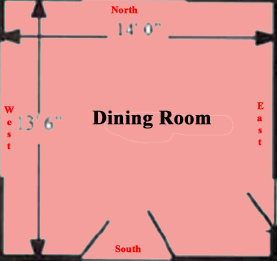

We'll start at the North Wall (top of the diagram above) and work around the room counterclockwise (West, South, East...)
The North Wall
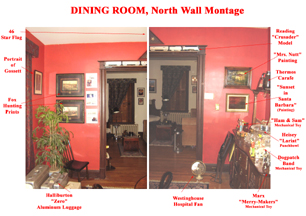
Click to Enlarge
The North Wall is has a doorway to the to both the Living Room. At one time, a pair of French doors separated the Living Room and the Dining Room (as they now separate the Florida Room from the Dining Room.) Since the rooms are fairly small, I suppose that the original owners removed the doors on the dining room side. Here is an excerpt from the Lewis catalogue that shows what these doors originally looked like:
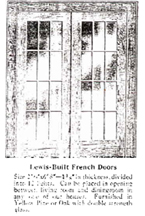
The Missing French Doors from the 1922 Lewis Catalogue
The North wall holds several fox-hunting prints and two oilpaintings. The top right painting is "Mrs. Nutt's Premonition" -- I found this in a thrift store in rural Virginia. I know nothing about it other than it has a sticker on the back that says "Mrs. Nutt" in rather large letters. The subject matter is a lonely-looking stucco houseoff in the country. The unusual thing is that Mrs. Nutt has painted a large and violent tornado approaching from the left. To the right of the vortex, the light is quite bright, but gloom and darkness approach. It is sorof American-Primitive-Macabre. I wonder who "Mrs. Nutt" really was.
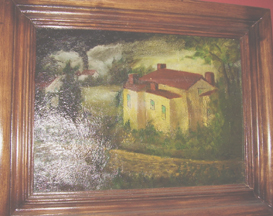

Mrs. Nutt's Premonition (left) Sunset in Santa Barbara (right)
Click to Enlarge
The second oil is called Sunset in Santa Barbara, and was purchased at a flea market in Los Angeles. The work is very subdued and conveys approach to the harbor from the Channel Islands as the dusk falls. Possibly there was some fog as well. The artist appears to have used a very large number of light wash coats to attain the almost dreamlike quality. I think that it is very nice, although the folks at the flea market did not seem to want it. The difference is that I put in a frame that respects the painting, there by changing it from "junk" to "Art".
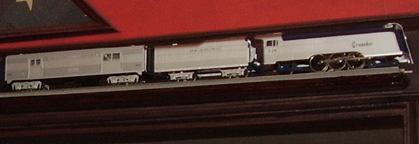
Click to Enlarge
A model of the famous Reading "Crusader" streamlined train that ran between Philadelphia and Newark in the 1930s is displayed above the North Doorway.
The West Wall

Click to Enlarge
The West wall of the Dining Room is primarily occupied by three large windows. In keeping with our de facto policy of using every available square inch, a "few" things may be found in the corners.
The Northwest corner contains a cabinet size photograph of the Statistician William Sealy Gossett. This fellow was the chief analyst at the Guiness Brewing Company in Ireland. He had visionary ideas well beyond his job and developed much of the theory now used in the analysis of experiments. HIs employers took a dim view of publishing any of his work for fear that the competition might use it against them. Thus, poor Gossett was compelled to use the pseudonym "Student" in his books and journal articles. Many of you may have taken an introductory course in Statistics where you may have learned Student's t-Test. I obtained this print from an antique store in Dublin, and when the owner of the store learned that I was a statistician by profession, we retired to the local Public House to raise a pint in honor of Gossett.
At the foot of the Northwest corner sits a child's rocker that came with the house. There is also a collection of all-aluminum Halliburton "Zero" luggage. At one time, this was the strongest (and lightest) luggage that you could buy, made of aircraft aluminum and completely watertight. I used this luggage until the 1990s when weight restrictions came into widespread use.
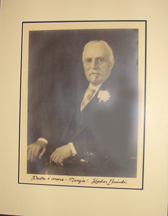
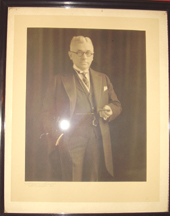
Portraits of Boiardi (left) and Gossett (right)
Click to Enlarge
In the Southwest corner, you will find a photograph of Hector (Ettore) Boiardi, a giant of the Culinary profession who was nationally recognized (in 1910..) as the greatest American Chef. He later sold the rights to use his name and image to the Campbell's Soup Company. Of all things, canned spaghetti bearing his name became an instant hit for Campbells. Their marketing division found that the typical American had trouble with his name, so they spelled it phonetically and thus "Chef Boy-Ar-Dee" was born. I hope that culinary history will bake up for this, becasue the legacy of Hector Boiardi si far mor than tasteless mush in a can...
This corner also holds our set of Samsonite Model 51 luggage. It took a while, but we were able to collect all the pieces including the hard-to-find attache case and hat box. These are lovely suitcases and are in pristine condition, but they are much too heavy to use for travel today.The South Wall
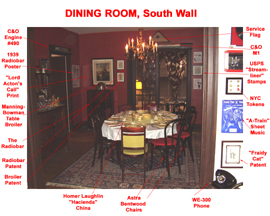
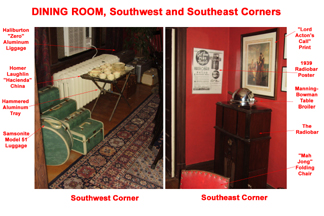
Click to Enlarge
In the left photo, you can see the dining room table set for a large party. The table, itself is oak with lion's feet (and claws); closed, it is 48" closed and several leaves enable it to be extended to a 96" x 48" oval. The table (solid oak, mind you...) was given to me in 1966 by a girl who "didn't want the old eyesore..." Thank you, Peggy G., wherever you are. The china pattern is Homer Laughlin Hacienda which was only made for a few years in the 1940s. Here are some closeups:

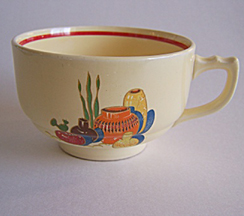
Click to Enlarge
The South "Wall" is largely a doorway to the Florida Room. In the South West corner is our collection of Samsonite luggage as described above. The Southeast corner has our pride and joy, the Radiobar that we put so much effort into restoring. Yes, it's a Radio and Yes, it's a complete bar. You should look at our Special Radiobar Page for more details.
Atop the Radiobar is the Manning-Bowman Table Broiler -- this remarkable solid chrome hemisphere ushered in a new era of broiling a steak at the table. heat is supplied by electrical resistance coils that are set far away enough from the meat to prevent fire and smoke. This device had several competitors, all of which were fairly expensive. The fad for cooking things at the table died and never came back. These are very nice sculptural objects.

Click to Enlarge
A model of the famous C&O M-1 streamlined steam turbine locomotive is displayed above the door to the Florida Room.
The East Wall
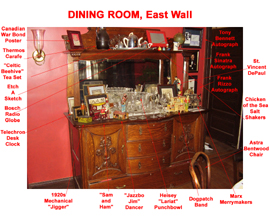
Click to Enlarge
The East Wall is primarily taken up by a large buffet that holds all the essentials, silver, china, etc. On it are displayed some of our most beloved treasures.
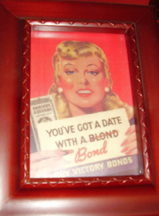
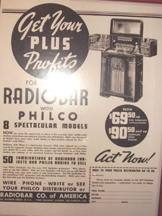

(left)Canadian War Bond Poster (middle) Radiobar Poster (right) Essential Italian Autographs
Click to Enlarge
On the top shelf are a Canadian war bond poster, a Thermos Carafe, a Celtic beehive tea set, an Etch-A-Sketch, and a Bosch Radio Globe.
Atop the main shelf are a number of family photos, and the centerpiece is the Heisey "Lariat" Punchbowl. Arrayed around the perimiter of the punchbowl are our Complicated Mechanical Toys, including Ham & Sam, the minstrels, "Jazzbo Jim", the Dogpatch Mechanical Band and the Marx Merrymakers. The buffet top also holds a statue of St. Vincent dePaul, the patron saint of thrift shoppers.
To the right of the buffet is our collwction of autographed photos of persons that "No Italian Home Can be Without", including Tony Bennett, Frank Sinatra, and Frank Rizzo.

Click to Enlarge
A model of the famous C&O No. 490 streamlined train is displayed above the door to the Kitchen.
This completes the Dining Room. Where would you like to go next?
The First Floor
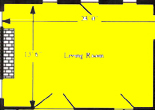

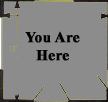



The Second Floor






The Basement
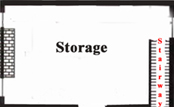


If you don't like clicking on pictures:
You are in the Dining Room
- Go to the dining Room
- Go to the Hallway
- Go to the Kitchen
- Go to the Florida Room
- Go to the Breakfast Room
- Go to the Master Bedroom
- Go to the Guest Bedroom
- Go to the Upstairs Hallway
- Go to the Library
- Go to the Office
- Go to the Basement Storage Area
- Go to the Dance Studio
- Go to the Workshop
- Look at the Exterior and History of the House
OK -- Go someplace else
Counter for THIS Page
Home | About Lindy | Last Week's Reviews | Upcoming Events | 1940s Collecibles
The Guide - Establishments - Travel - Accessories
Music | Links | Photo Gallery | Extras | Contact